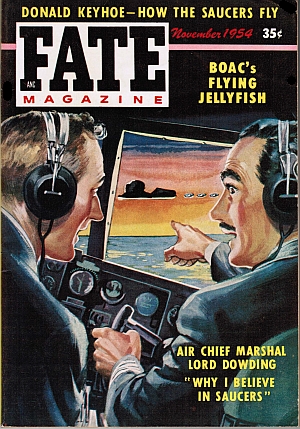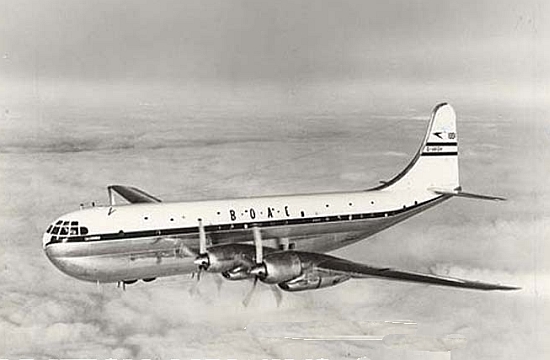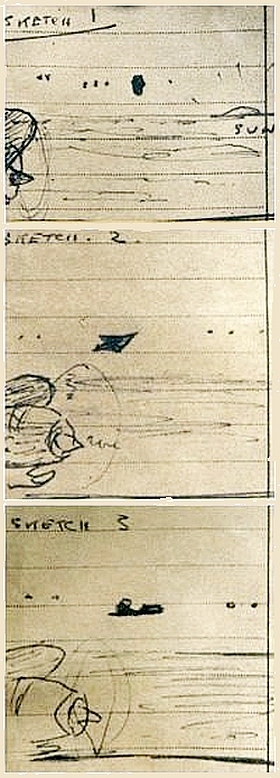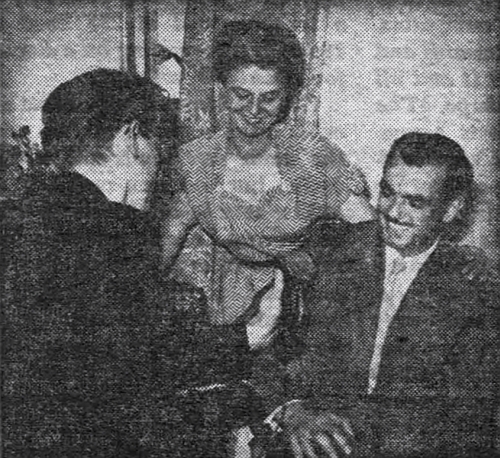


ONE of the most unusual and inexplicable UFO sightings hit all the London dailies on July 1 when British Overseas Airways Corporation announced that one of their Stratocruisers, the Centaurus, had been “escorted” for 80 miles over the coast of Labrador by seven unidentified flying objects. The objects changed shape and formation yet easily kept station with the giant airliner whose crew of 11 together with 51 passengers watched the occurrence and speculated upon its mystery.
The Centaurus, one of BOAC's fleet of sky-cruisers, was on a routine flight from New York to London. It left Idlewild Airport on the afternoon of June 29 for Goose Bay, Labrador, the last refueling point before the easterly ocean crossing. At approximately 8 p.m. (EST), just as the sun disappeared below the western horizon, the plane was flying a northeasterly course. Less than 200 miles remained before touchdown at Goose Bay.
The following is an extract from the Voyage Report of Captain James Howard in command of the aircraft. Captain Howard is a former bomber squadron leader with over 7,500 flying hours recorded in his log. This was his 265th Atlantic crossing.
“At 0105 G.M.T. today (June 30) about 150 nautical miles southwest of Goose Bay, height 19,000 feet, flying in clear weather above a layer of low stratus cloud, I noticed on our port beam a number of dark objects at approximately the same altitude as our aircraft. I drew the attention of the First Officer (Lee Boyd), to them. He said he had just noticed them also. I jokingly said that they reminded me of flack bursts. He agreed. (Sketch 1).
“It then became apparent that they were moving along on a track roughly parallel to ours and keeping station with us. The First Officer then called Goose approach to ask if there were any aircraft in our area (0107 G.M.T). They said No. During this time the shape of the large object changed slightly — also the positions of the smaller ones relative to the big ones. Some moved ahead, some behind. The First Officer then told Goose what we were watching and they said they would send a fighter to investigate. At this time the objects resembled Sketch II.

“The shape of the large one continually changed but its position relative to us did not — always about 90 degrees to port. The distance from us appeared not less than five miles, possibly very much more. During this time both engineers, both navigators, the radio officer, two stewards and the stewardess watched it and all of us agreed on its shape. The number of small objects accompanied it (usually six were visible), and all were agreed that we had never seen anything like it before. At about 0120 the fighter reported that he was approaching us. The objects immediately began to grow indistinct until only one was visible. This grew smaller and finally disappeared (0123 G.M.T.) still at the same bearing to us. I reported to the fighter which direction to head for and then commenced descent to Goose, landing at 0145 G.M.T. As we taxied in another fighter was despatched to take over from the first.
“A U.S. Air Force Intelligence Officer met us and we gave him the story. I spoke to Fighter Control and he said he picked us up at 0113 G.M.T. (when we had the object in sight), but had nothing else on his screen but us.
“All who watched the objects are sure that the large one at any rate was no sort of winged aircraft. The small ones were just dots. They left no vapor trails. No lights were seen, just black silhouettes. The visibility at this altitude was unlimited with no cloud other than low overcast. The sun had just set. A large flock of birds might explain it if they were birds that could fly at a true airspeed of 238 knots at 19,000 feet formating on a Boeing for about 80 miles.”
Captain Howard added that another company’s aircraft had gone the same way about 25 minutes earlier but had seen nothing.
The release of this sensational report sent London reporters hurrying for interviews with the Captain and crew. The passengers apparently had dispersed by the time the Press arrived as no statements from them are recorded.
A News Chronicle reporter who interviewed Captain Howard at his home in Bristol quotes him as saying, “The formation of objects appeared suddenly and they were obviously not aircraft as we know them. All appeared black. I’ll swear they were solid. They were between five and 50 miles distant. There was a big central object which appeared to keep changing shape — sometimes it was wedge-shaped, sometimes like a dumb-bell, sometimes like a sphere with a projection. The six smaller objects dodged about either in front or behind the ‘parent'. They all faded away rapidly when the Sabre jet fighter contacted us.”
First Officer Lee Boyd, another former wartime squadron leader also living at Bristol, was quoted by a Daily Express reporter: “It was the greatest thrill of my life. I am willing to swear that what we saw was something solid, something maneuverable, and something that was being controlled intelligently.”
The same newspaper quoted the 31-year-old navigator George Allen: “I am absolutely convinced that the objects we saw were a base ship of some kind with a number of satellites linked with it.”
Meanwhile, the Daily Sketch approached the subject from a more feminine angle and quoted the 28-year-old air hostess Daphne Webster of Hounslow, Middlesex. “It was the most exciting sight I've ever seen,” she said, “but a little creepy. I was making tea when I saw the objects. The big one was constantly changing its size and shape — one minute like a cigar, then an orange, then a mushroom. The smaller ones kept changing formation but not their shape. Every one of us was far too intrigued to be afraid.” The Daily Mail added an additional statement of Miss Webster's: “The objects appeared to be not less than five miles away. It was difficult to assess their size because there was nothing in the sky at the time to measure them against. We are quite certain that the machines were in flight and were something solid.”
The best news coverage of the day was reserved for the Bristol Evening Post whose reporter found the pilot, first officer and navigator more expansive when relaxed in their homes than they had been facing the battery of newspapermen at London airport. Under a banner heading of FLYING OBJECTS “AS BIG AS A BLOCK OF FLATS” the Evening Post quotes Captain Howard, “They were definitely not ordinary aircraft of any type — or imagination. I've never seen anything which remotely resembled them before. They were not saucers — they never looked discshaped or flat. The size was impossible to estimate because we didn't know how far away they were. If they were 20 miles away the big object must have been the size of a block of flats; if five miles perhaps the size of a house.
“By comparison, if the big one was the size of the Queen Mary, the small ones were about the size of the tugs towing her out of harbor. The small ones were no more than bright dots — I couldn't distinguish any shape. They flew sometimes ahead or behind the large one, but never above or below." Discussing his radio call to Goose Bay and the dispatch of a Sabre jet fighter, Captain Howard continued, “The fighter was closing in within a minute or two. He signalled, "I am now 20 miles from you. What do they look like now?' And in that moment I suddenly found I couldn’t see the small ones and the large one was beginning to get smaller. Within two or three minutes it had diminished and finally was just a speck, and then it was gone. It didn't go forward or back, just got smaller until it disappeared.”
Captain Howard went on to say that it was possible the object was flying directly away from him at great speed and that the changing shape may have been caused as it banked or turned, but at no time did it do anything suddenly. “I have never believed seriously in flying saucers,” he concluded, “I am not sure that I do now. All I know is that I saw something extremely odd which was not an airplane.”
Not made known immediately was the fact that Captain Howard and his crew were interviewed by high-ranking Air Force intelligence officers after they landed at London Airport. Quoted by the Daily Sketch the Captain said: “The RAF are obviously very interested. No one took pictures — I wish now I had had my camera. But we all saw the same.”
On the same day the Daily Express, noted for its many discerning scientific articles, published a three-column article by its Science Reporter under the banner FLYING SAUCER? - NO SAYS CHAPMAN PINCHER. Mr. Pincher’s theory is that the “flying saucers” seen by the crew of the Centaurus were nothing more than a reflection of the aircraft itself from a wavy layer of air. “Could a layer of air in which there was no cloud act as a mirror in this way?” he writes. He thinks that it could, especially as the Stratocruiser is an exceptionally shiny plane.
“At various levels in the atmosphere,” his article goes on, “there are regions called ‘inversions’ where the air temperature changes. Boundaries between layers of warm and cold air are such good mirrors that they cause mirages in the desert. Because of the turbulence of the atmosphere, the boundary is sometimes rippled and breaks up an image into several parts which, after reflection, can be seen at eye-level.
“If my theory is right, the saucers could have been seen only in the direction of the sun’s rays — through the port-side windows of the aircraft which was travelling northeast while the sun was setting in the northwest.”
Chapman Pincher discussed his theory with Captain Howard who knows all about ‘inversions.’ The latter agreed that it was a possibility but thought “that the saucers looked too solid.”
Discussing the fact that the objects followed the plane for 80 miles and then disappeared just as a fighter was coming up to investigate, Mr. Pincher states: “Inversions sometimes stretch for hundreds of miles, so the reflection would seem to travel with the plane. The disappearance of the saucers may have been due to a change of light — remember the sun was setting — or the ‘inversion’ may have petered out.”
Despite Chapman Pincher’s discussion of his theory with Captain Howard, the pilot strongly disagreed with the former’s article — so much so that on July 5 a letter headed I CHALLENGE PINCHER was featured on the center page of the Daily Express and signed by the pilot who started it all. The Captain’s letter says: “I am the pilot concerned in the recent sighting of sky objects over Labrador, and I challenge Mr. Chapman Pincher’s explanation that this could have been merely the reflection of my own aircraft.
An ‘inversion’ can act as a mirror and reflect, or sometimes refract, distant objects — true. But not in the way illustrated by Mr. Pincher. Had an inversion existed above us at the time (highly unlikely with the high temperature), we might have seen a reflection of the sunset, nothing more; certainly not six small black dots and one large variable shaped thing.
“Was it a shadow that we saw? Plausible, maybe, but shadows are thrown away from the light source, not towards it.”
In the three sketches made by Captain Howard at the time of the sighting it will be noticed that the objects appear between the plane and the setting sun but not directly in opposition. The sun had actually disappeared below the horizon before the objects vanished.

Interviewed on July 3 by BBC commentator John Ellison for the popular Saturday night radio and TV program “In Town Tonight” Captain Howard said: “At first my co-pilot, Lee Boyd — a Canadian of immense experience as a pilot — and I thought the big machine might be a delta- or swept-wing bomber, but it changed shape several times. I'm quite sure that it was a three-dimensional object and not a mirage. I'm still skeptical of the flying saucer theory, or piloted aircraft from other planets, and all the other tales. All I am willing to believe is what I saw and what my crew saw. Whether these objects were piloted craft or what they were I cannot speculate.”
BOAC’s London Press Relations office were extremely cooperative in my investigations of this mysterious sighting. One of their officers, however, pointed out to me that “never at any time have we called the things ‘saucers’ — we prefer the word ‘objects’ or ‘unidentified flying objects’. Everyone has been most intrigued by this phenomena but we know nothing further about it than what you have already been told.” This statement is verified by the fact that there are no rumors among the staff and personnel of No. 3 Line Operations Office at London Airport, the section responsible for the flight of the Centaurus.
Scientist Arthur C. Clarke, author of “The Exploration Of Space” (Harper 1952), who has been investigating a number of US sightings this year, flew over a parallel course to that of the Centaurus only 10 hours after the objects were seen. This was purely coincidental as he was on his way to Hudson Bay from New York to photograph the eclipse of the sun.
Interviewed on his return to London on July 13 he said to me: “This is undoubtedly one of the finest sightings ever recorded from the he viewpoint of the authenticity of the witnesses. However, the objects were obviously not solid bodies and there are so many various types of mirages that speculation is fruitless. If the true explanation of this sighting could be established it would probably clear up much of the ‘flying saucer’ mystery.” He went on to explain that many of the eclipse photographs he took were “cluttered up with ‘flying saucers’ due to multiple light refraction in the camera lenses” — an obvious explanation of many of the so-called authenticated photographs of ‘saucers.'
See also Martin Shough's analysis of this event: The BOAC Labrador sighting of June 29,
1954,
and Phillip Robertson's letter to Dr Willy Smith, Some considerations on the Seven Isles, Quebec, Canada case of June 29, 1954
|
|
||||
|
|
|
|
|
|